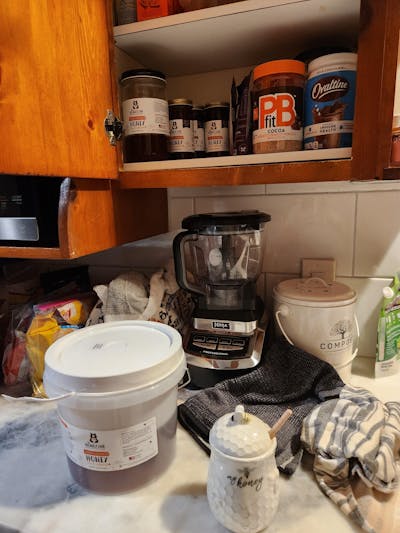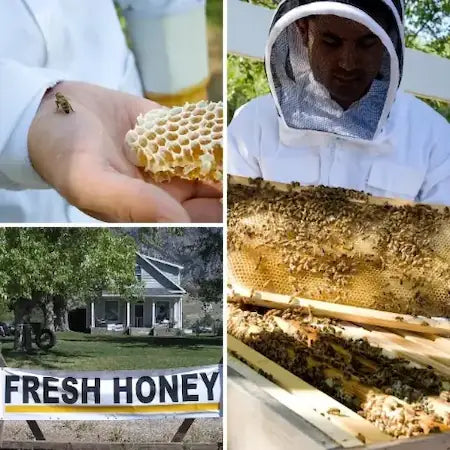Introduction:
When choosing candles, most of us focus on scent, color, or how they enhance the ambiance. But did you know that the type of candle you burn also impacts the environment? Beeswax, paraffin, and soy candles are three popular options, each with unique qualities. In this post, we’ll compare these three types of candles, focusing on their environmental impact, to help you make a more informed and eco-friendly choice.
What Are Beeswax Candles?
Beeswax candles are crafted from beeswax, a natural byproduct of honey production. Bees secrete this wax when building honeycombs, and it’s collected by beekeepers in a way that doesn’t harm the bees. Once harvested, the beeswax is filtered and molded into candles.
Benefits of Beeswax Candles
Beeswax candles are known for their clean-burning properties. They don’t release harmful chemicals into the air, and they even emit negative ions when burned, which can help purify the air by neutralizing pollutants like dust, mold, and allergens.
Environmental Impact
Beeswax candles are a top choice for eco-conscious consumers. Beeswax is a renewable resource, and these candles are biodegradable, meaning they won’t contribute to landfill waste. However, ethical sourcing is key—sustainable bee farming practices are necessary to ensure bees are not harmed and their ecosystems are preserved.
What Are Paraffin Candles?
Paraffin candles are made from paraffin wax, a byproduct of petroleum refining. This wax is widely used in candle making because it’s affordable and versatile, easily dyed, and scented to create various candles.
Common Usage
Paraffin candles are the most common type of candle, found everywhere from grocery stores to specialty shops. Their low cost and wide availability make them a popular choice for many consumers.
Environmental Concerns
The environmental impact of paraffin candles is significant. Derived from petroleum, paraffin is a non-renewable resource. The extraction and refining process contributes to environmental degradation and greenhouse gas emissions. When burned, paraffin candles release harmful chemicals like toluene and benzene, contributing to indoor air pollution and potential health risks. Additionally, paraffin wax is not biodegradable, adding to the issue of non-decomposable waste.
What Are Soy Candles?
Soy candles are made from soy wax, a hydrogenated form of soybean oil. This plant-based wax has gained popularity as a more sustainable alternative to paraffin wax, especially among those looking for a natural, eco-friendly option.
Benefits of Soy Candles
Soy candles burn cleaner and longer than paraffin candles, producing less soot and fewer harmful chemicals. They also have a lower melting point, which allows for a slower, more even burn. Soy wax is also an excellent carrier for fragrance, making it a popular choice for scented candles.
Environmental Impact
Soy wax is a renewable resource, making soy candles a more sustainable option compared to paraffin. However, the environmental benefits of soy candles depend on how the soybeans are grown. If the soy is sourced from large-scale industrial farms that rely on pesticides and contribute to deforestation, the environmental impact can be significant. Additionally, not all soy candles are 100% soy; some are blended with other waxes, which can reduce their eco-friendliness.
Comparing Beeswax, Paraffin, and Soy Candles
Air Quality
- Beeswax Candles: Beeswax candles purify the air by releasing negative ions, making them the best choice for improving indoor air quality.
- Paraffin Candles: Paraffin candles are the worst option for air quality, as they release toxic chemicals and soot that can harm your health.
- Soy Candles: Soy candles are better than paraffin in terms of air quality, as they produce less soot and fewer toxins, but they don’t purify the air like beeswax candles.
Sustainability
- Beeswax Candles: Beeswax is a renewable and biodegradable resource, making these candles highly sustainable, provided the beeswax is sourced ethically.
- Paraffin Candles: Paraffin is derived from non-renewable fossil fuels, making it the least sustainable option.
- Soy Candles: Soy is a renewable resource, but its sustainability depends on how the soybeans are grown and harvested.
Carbon Footprint
- Beeswax Candles: Beeswax has a low carbon footprint, especially when sourced locally and sustainably.
- Paraffin Candles: Paraffin candles have a high carbon footprint due to the extraction, refining, and production processes associated with petroleum.
- Soy Candles: Soy candles have a moderate carbon footprint, but this can vary depending on farming practices and transportation.
Health Impacts
Beeswax Candles: Beeswax candles offer health benefits by purifying the air and burning cleanly, reducing exposure to harmful chemicals and soot.
Paraffin Candles: Paraffin candles can pose health risks due to the release of toxins like benzene and toluene, which are known carcinogens. Long-term exposure to these chemicals can aggravate respiratory issues and contribute to other health problems.
Soy Candles: Soy candles are a healthier option than paraffin, as they produce fewer toxins and less soot. However, they don’t have the air-purifying qualities of beeswax candles.
Ethical Considerations
Beeswax Candles: When choosing beeswax candles, it’s important to support brands that use ethically sourced beeswax from sustainable beekeeping practices. This helps protect bee populations and their natural habitats.
Paraffin Candles: The ethical concerns with paraffin candles stem from their reliance on fossil fuels, which contribute to environmental degradation and climate change.
Soy Candles: Ethical considerations for soy candles revolve around the agricultural practices used to grow soybeans. Supporting organic or non-GMO soy can help reduce the environmental impact and promote sustainable farming.
Conclusion
In the comparison between beeswax, paraffin, and soy candles, beeswax candles emerge as the most environmentally friendly option, offering benefits for both air quality and sustainability. Soy candles come in second, providing a cleaner-burning alternative to paraffin but with some caveats regarding farming practices. Paraffin candles are the least eco-friendly and healthiest choice, with significant environmental and health drawbacks.
Next time you’re shopping for candles, consider these factors and opt for beeswax or soy candles. Your home, health, and the planet will thank you.


















